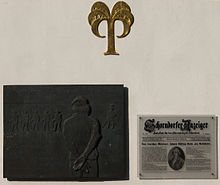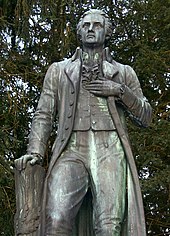Johann Philipp Palm
Johann Philipp Palm (born December 18, 1766 in Schorndorf ; † August 26, 1806 in Braunau am Inn ) was a bookseller in Nuremberg . He published the pamphlet Germany, directed against Napoleon , in his deep humiliation in the publishing house of his bookstore and was sentenced to death for it. That is why he was also referred to as the "martyr of freedom of the press".
biography
As the son of the "surgeon and Umgelders" (surgeon and "tax collector") Johann Leonhard Palm, he grew up in Schorndorf and then learned the book trade with his uncle Johann Jakob Palm in Erlangen . After his apprenticeship he became an assistant in the Stein bookstore in Nuremberg, married the daughter of Anna Catharina Barbara, known as Anna Maria, on February 27, 1796 in the St. Sebald Church in Nuremberg, and so came into the possession of the Steinschen Bookstore (founded around 1600). Johann Philipp Palm had three children with Anna Catharina Barbara: Anna Maria (born December 1795), Johann Wolfgang Philipp (also Hans, born October 29, 1798) and Anna Sophie (born 1800).
After the occupation of Nuremberg by French troops in March 1806, the 144-page publication Germany in its deep humiliation was published by Palms Buchhandlung in July, calling for resistance against the French and their Bavarian allies. In Augsburg it fell into the hands of French officers who reported the whole thing. As a result, house searches took place on July 28th and August 4th in the Palms house in Nuremberg. However, Palm was on a business trip and first went to his uncle in the Prussian and thus safe Erlangen. Despite warnings, he secretly returned to Nuremberg, where a beggar to whom he had recently paid a few talers alms denounced him.
On August 14, he and his lawyer Rudolf Sigmund von Holzschuher were brought to Ansbach to see the French commander-in-chief, Jean Baptiste Bernadotte . This transferred him to the French-occupied fortress town of Braunau am Inn on August 22nd .
Here he was told that his arrest was based on a decree by Napoleon on August 5th. A French military tribunal sentenced him to death on August 25, despite his pledges of innocence . When shooting the next day Palm was only wounded twice by gunfire, so it only in the third attempt by a coup de grace was killed.
Whether the Bavarian King Max I Joseph advocated a pardon for Palm, as is often rumored, is still controversial today. It could indicate that Palm's co-defendant Karl Friedrich von Jenisch was pardoned on the basis of the king's intercession.
Palm hid the actual authors of the pamphlet until the very end. In the literature, both Count Julius von Soden and the chamber assessor Julius Conrad von Yelin from Ansbach (managing director of the Palmschen Buchhandlung branch opened in Passau in 1803) and judicial advisor Johann Georg Leuchs are named. His death caused a sensation in Germany as an example of the despotic rule of Napoleon.
There are no more descendants of Johann Philipp Palm himself today; the Munich photographer Laura Maria Palm († August 21, 1953, great-granddaughter) was the last descendant. Descendants of the Palm family, traceable since 1419, are widespread today.
Honors, commemorations

Memorial plaques at the Palm Pharmacy in Schorndorf
|

Another plaque at the Palm Pharmacy in Schorndorf
|
- In 1866 a memorial for him was erected in Braunau based on a design by the sculptor Konrad Knoll .
- In memory of Palm, the Palm Foundation, a non-profit association in Schorndorf, has awarded the Johann Philipp Palm Prize for freedom of expression and freedom of the press every two years since 2002 . The 2004 winners were the journalist Sergei Duwanow from Kazakhstan and the Afghan women's magazine Malalai . In 2006 Asya Tretyuk (journalist from Minsk , Belarus) and Pap Saine (journalist from Banjul, Gambia, for the daily newspaper The Point ) received the award. The Palm Foundation was founded by Maria Palm and Johann Philipp Palm (1918–2004), who had common ancestors with his namesake discussed here.
- The Palm & Enke publishing house in Erlangen still bears the name Palm today. This publisher is named after the above-mentioned uncle Johann Jakob Palm (1750–1826, “died as a result of falling out of a carriage that shied away from the horse”), with whom Johann Philipp completed his apprenticeship as a bookseller in Erlangen. The publishing house was taken over by Johann Ernst August Palm (1788–1846), the son of Johann Jakob. The Palm and Enke publishing house is no longer owned by the Palm family.
- The Johann Philipp Palm School in Schorndorf (formerly the Schorndorf Commercial School) has existed since 2009.
- Johann-Philipp-Palm-Straßen as in Albstadt , Bremen - Blumenthal , Gutach (Black Forest Railway) and Schorndorf were named after him, as well as the Palmplatz in St. Johannis (Nuremberg) and in Braunau.
- The 15th Braunau Contemporary History Days in 2006 dealt with the history of Palm under the title “Involuntary Hero”. In Klagenfurt, today's Palmengasse was called Palmgasse during the Nazi era.
- A relative of Palms, Johann Jakob Palm , who fled after his execution, fell fatally from his horse in Münchaurach, where a memorial stone on the street commemorates the events.
Fonts
- Germany in its deep humiliation . 1906. [1]
- An unprinted letter from Johann Philipp Palm. The “Palm” association of younger booksellers in Munich to celebrate the 40th foundation festival. Munich on May 20, 1914 . Palm Association of Younger Booksellers, Munich 1914, 4 pages.
literature
- Biography of Johann Philipp Palm's bookseller in Nuremberg. Shot at Braunau on August 26, 1806 on Napoleon's orders. Along with a copy of the text: Germany in its deep humiliation, as the cause for Palm's execution. Palm, Munich 1842 ( digitized version )
- Constantin von Wurzbach : Palm, Johann Philipp . In: Biographisches Lexikon des Kaiserthums Oesterreich . 21st part. Kaiserlich-Königliche Hof- und Staatsdruckerei, Vienna 1870, pp. 241–243 ( digitized version ).
- J. Braun: Johann Philipp Palm . In: Allgemeine Deutsche Biographie (ADB). Volume 25, Duncker & Humblot, Leipzig 1887, pp. 102-104.
- Martin Riegel (* 1884): The bookseller Johann Philipp Palm. A picture of life . Broschek and Co., Hamburg 1938.
- Gert Kollmer-von Oheimb-Loup : The Palm family. Social mobility in a corporate society . (= Contributions to economic and social history in southwest Germany; Vol. 1). Scripta-Mercaturae-Verlag, Ostfildern 1983, ISBN 3-922661-08-4
- Christine Glas: Johann Jacob Palm (1750–1826). An Erlangen publisher and bookseller . (= Erlanger studies; Vol. 78). Palm and Enke, Erlangen 1988, ISBN 3-7896-0178-0 , with a publisher's bibliography 1780–1826 (plus master's thesis, University of Erlangen-Nuremberg 1987).
- Uwe Meier: Palm, Johann Philipp. In: New German Biography (NDB). Volume 20, Duncker & Humblot, Berlin 2001, ISBN 3-428-00201-6 , pp. 20 f. ( Digitized version ).
- Bernt Ture von zur Mühlen : Napoleon's judicial murder of the German bookseller Johann Philipp Palm . Bramann, Frankfurt am Main 2003, ISBN 3-934054-16-1 .
Web links
- Literature by and about Johann Philipp Palm in the catalog of the German National Library
- Germany in its deep humiliation (digitized version)
- Johann Philipp Palm on www.epoche-napoleon.net
- www.palm-stiftung.de
Individual evidence
- ↑ Information on Palm's dungeon according to Max Eitzlmayr: Braunau - the historic trading town . Braunau 1997 ( Memento of the original from September 23, 2015 in the Internet Archive ) Info: The archive link was inserted automatically and has not yet been checked. Please check the original and archive link according to the instructions and then remove this notice.
- ^ Hermann Theodor Schneider: "Streets and squares of Klagenfurt." 4th edition Landeshauptstadt Klagenfurt, Klagenfurt 2009, page 274f.
- ^ Max Döllner : History of the development of the city of Neustadt an der Aisch until 1933. Ph. CW Schmidt, Neustadt an der Aisch 1950; Reprint ibid 1978, p. 620, note 4.
| personal data | |
|---|---|
| SURNAME | Palm, Johann Philipp |
| BRIEF DESCRIPTION | German bookseller |
| DATE OF BIRTH | December 18, 1766 |
| PLACE OF BIRTH | Schorndorf |
| DATE OF DEATH | August 26, 1806 |
| Place of death | Braunau am Inn |



